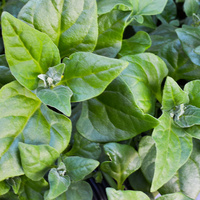Common name: New Zealand spinach
Other common names: Warrigal greens, Warrigal cabbage, Warrigal spinach
Description
New Zealand spinach or Warrigal greens is a spinach-like plant originating in the southern hemisphere, where it occurs on New Zealand's North Island and the east coast of Australia, extending from the coastal southeast to the town of Rockhampton.
It is a short-lived perennial up to 50 cm (1.6 ft) tall, with a low-lying, sprawling, creeping habit of soft stems radiating up to 2 meters (6.6 ft) outward from the centre.
The leaves are arrowhead-shaped, 7 to 10 cm (2.8 to 4 in) long, soft, succulent and medium green. Fine hairs on the surface and the stems give the plant a fuzzy, glistening appearance.
The flowers are small, yellow and arise from the leaf bases throughout the year. They are bisexual, with both male and female parts but require bees or other insects for pollination. The pollinated flowers are followed by angular, bell-shaped fruit up to 1.25 cm (0.5 in) long, with pointed horns, becoming dark brown when mature and with three or more small seed inside.
Use
The young leaves and stems were an important vegetable in the diet of Australia's and New Zealand's native people long before Europeans arrived. Though still eaten today, its use is overshadowed by non-native species such as English spinach. It is now cultivated on a limited scale in home gardens and is sometimes available as a niche vegetable at farmer's markets.
Unlike English spinach, it is suited to be grown in warm climates with high summer temperatures and is slow-bolting (a reduced tendency to flower). This helped encourage its introduction and cultivation as a spinach crop in upland areas in the Philippines and some Central and South American countries.
Though not related to English spinach, the young leaves have a similar texture and flavour, albeit milder and slightly bitter. However, like English spinach, it is high in oxalic acid. Only the young leaves and the stem tips are eaten, and they need to be blanched for a couple of minutes and the blanching water discarded as a precaution. After blanching, it can be stored frozen like spinach or used straight-away in vegetable dishes, salads, pestos, quiches and stuffings.
It grows naturally in seashore environments and is used extensively in coastal dune plantings in its native range to control erosion and sand drift.
Health use
The cooked leaves and stems are reportedly a good source of iron, calcium and phosphorus.
Climate
Grows naturally in sub-humid to moderately humid subtropical and tropical mid- to high-elevation climates, generally areas with annual lows of 8 to 19°C, annual highs of 17 to 28°C, annual rainfall of 600 to 1800 mm and a dry season of 7 months or less.
Growing
New plants are usually started from seed, which benefit from pre-soaking in water for twenty-four hours before sowing. Performs best in rich or well-manured, free-draining loam and sand soils of a moderately acid to slightly alkaline nature, generally with a pH of 5.8 to 8.0, and sites with full to partial sun exposure.
The seed are best sown in spring to early summer in subtropical areas and near the end of the rainy season in tropical areas, when there is sufficient soil moisture for good germination and growth, and the humidity level has started to fall.
Problem features
It has a creeping habit and seeds freely, producing viable seed that are easily dispersed by water. In some regions, it is recorded as an invasive species, a term applied to serious weeds. The Hawaii Pacific Weed Risk Assessment (HPWRA) project assessed it as a high weed risk species for Hawaii.
The uncooked leaves and stems have a high oxalic acid content which may adversely affect kidney function.
Where it grows
References
Books
-
Grubben, G.J.H. & Denton, O.A. (Editors) 2004, Plant Resources of Tropical Africa, Volume 2 : Vegetables, PROTA Foundation, Backhuys Publishers, Leiden
-
Macmillan, H. F. 1943, Tropical planting and gardening : with special reference to Ceylon, 5th ed, Macmillan Publishing, London
-
Rubatzky, V. E. & Yamaguchi, M. 1997, World vegetables : principles, production, and nutritive values, 2nd ed., Chapman & Hall, New York
-
Tindall, H. D 1983, Vegetables in the Tropics, Macmillan Press, London
-
Toensmeier, E. 2007, Perennial Vegetables : From Artichokes to Zuiki Taro, A Gardener's Guide to Over 100 Delicious and Easy to Grow Edibles, White River Junction, Chelsea Green Publishing, Vermont
-
Winters, H. F & Miskimen, G. W. 1967, Vegetable gardening in the Caribbean area, U.S. Dept of Agriculture, Washington D.C.



